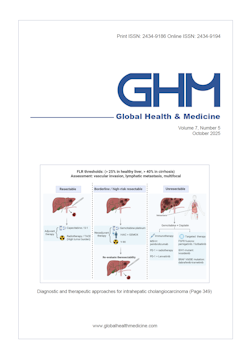Global Health & Medicine 2024;6(4):273-276.
Association between the paracaval branches of the caudate lobe and the three major hepatic veins in liver casts: Locating the cranial boundary of the caudate lobe
Kumon M, Namikawa T, Takemura N, Kogure M, Sakamoto Y
According to Couinaud's definition, the cranial boundary of the caudate lobe is delineated by the three major hepatic veins. However, many branches of the caudate lobe go through the ceiling that is composed of these hepatic veins. The cranial boundary of the caudate lobe should be determined by employing the portal segmentation. We conducted a study based on the dissection of 37 colored resin liver casts to reveal the caudate branches of the liver. The paracaval portal vein branches (PCPvs) were defined as cranial portal branches from the main trunk or first-order branch of the portal vein distributed in front of the inferior vena cava, according to Kumon's classification. The PCVs were traced to reveal the cranial boundary of the caudate lobe. Results showed that in 18 cases (49%), the PCPvs reached the liver surface through the gap between the right and middle hepatic veins (type RM, n = 11), between the tiny branches of the middle hepatic vein (type M, n = 4), and between the middle and left hepatic veins (type ML, n = 3). The PCPvs did not reach the liver surface in 19 cases (type 0). No PCPvs reached the hepatic surface behind the right hepatic vein. Half of the PCPvs in the liver reached the hepatic surface beyond the boundary composed of the three major hepatic veins. Recognition of the PCPvs in the liver is indispensable to perform anatomically precise liver resections involving the major hepatic veins.
DOI: 10.35772/ghm.2024.01012







